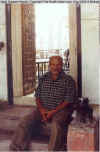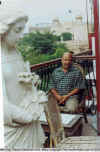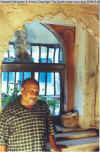|
|
the-south-asian.com August 2004 |
||||
|
August
2004 Culture & History
Pitamber
Singh
River-linking
project Lifestyle Orange
cauliflower Lehngas - a limited collection Books Between
Heaven and Hell
|
|
||||
|
Page 1 of 4 Iqbal Hussain – of Lahore, Pakistan interviewed by Salman Minhas
Iqbal Hussain is the enfant terrible of Pakistan. He is unconventional, outspoken, radically innovative, avant-garde and more – all of which appears starkly in his paintings. He is of medium height, is deep chested, and paunchy. His self-assurance and that firm torso exude the kind of authority and sensitivity that does not need advertising. In repose, his gray eyes are hooded, inscrutable, yet twinkling with buoyancy, "the unbearable lightness of being". In one of his self-portraits with a cap he could almost pass off as a French wine maker. His house interiors juxtapose the multi-pan-religious and earthy tones, bearing statues of Buddha, Hanuman, Nandi Bull, Virgin Mary with a church bell over her head. He has painstakingly collected old doors, enameled tiles, and mirrors and put them in a real life canvas of his home- haveli. In retrospect, one could almost
hear at times the faint strains of Beethhoven’s Ode to Even when he talks of the
sufferings of his working class neighbors and background,
Iqbal Hussain’s paintings have been requested by the Jordanian Princess Wijdan Ali for the Jordanian Gallery of Fine Arts. His paintings/work were the only one from Pakistan nominated in 34 out of 321 paintings selected for UNESCO Headquarters Prize in 1995, Paris. In 1998 one of his paintings was auctioned at the Sotheby’s auction house in London. His other exhibitions are given below. Iqbal Hussain’s works show his insights into [but also seek to transcend] the darkness, shadows, despair, desolation and no-exit life situations. Just as "Mood Indigo", by Duke Ellington was " a story about a little girl’s love for a little boy … who one day doesn't come. 'Mood Indigo' tells how the little girl / courtesans feels waiting for society’s acceptance. Iqbal Hussain’s work bears the hallmark of true sophistication, which is audacious simplicity. His work, like that of all great artists is done in faith and hope. As a February born Aquarian, Iqbal Hussain’s zeal in work stands in the same vein as William’s Faulkner work, which in his Nobel Prize speech he said sought to: " .. create out of the materials of the human spirit something which did not exist before"
Also visit
|
|||||
| Copyright © 2000 - 2004 [the-south-asian.com]. Intellectual Property. All rights reserved. | |||||
| Home | |||||





